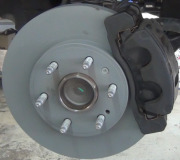You've already figured out the first step. That is opening the bleeder screws. Next time this happens, loosen the soft metal line nuts right at the master cylinder. If that lets the brakes release, the best suspect is the brake light switch is misadjusted and is holding the brake pedal down a little.
A less-common possibility is when the brake line started leaking, the brake pedal got pushed more than half way to the floor. This is also a common mistake when pedal-bleeding with a helper. Crud and corrosion build up in the lower halves of the bores in the master cylinder where the pistons don't normally travel. It's fairly common, when pushing the brake pedal more than half way, either when bleeding or when surprised by a sudden leak, the rubber lip seals on those pistons get ripped as they run over that crud. The most common symptom is a slowly-sinking brake pedal that often doesn't show up until two or three days later. The less-common possibility is some of that corrosion got scraped off and pushed out the port. Ports for rear drum brakes have a "residual check valve" in them that lend themselves to becoming plugged easier than the port for disc brakes, but it is still something to consider.
If the front brakes do not release when loosening the line at the master cylinder, you'll need to open the circuit at various other places to figure out where the pressurized brake fluid is being trapped. The most common suspect is a front rubber flex hose. I mentioned the other possibilities first because this happened right after the repairs to the rear line. A flex hose that is coming apart inside is its own problem. It isn't caused by anything related to repairing the rear line.
Wednesday, October 23rd, 2019 AT 5:42 PM



